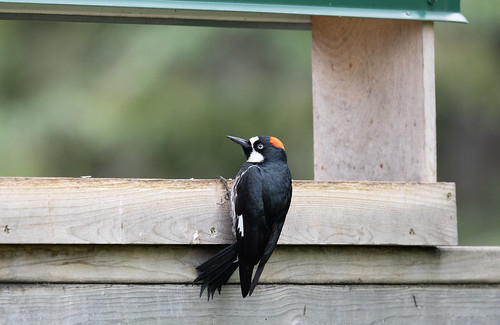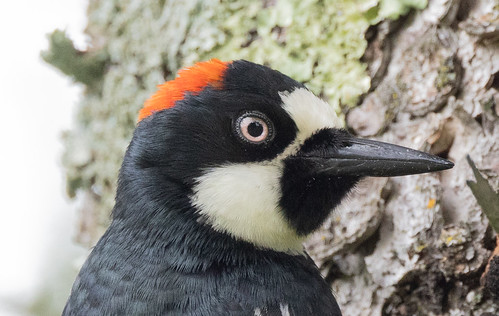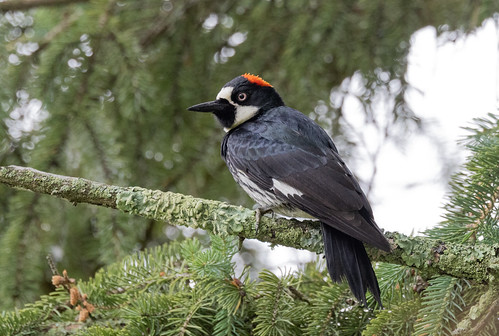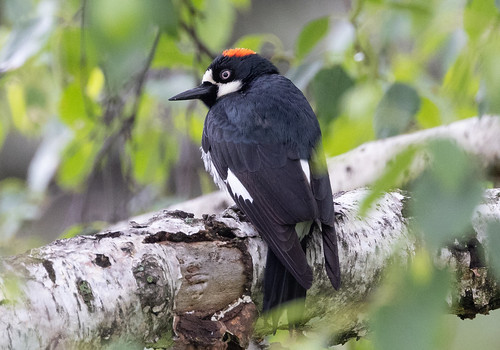On July 2, Russell Stewart was looking out at his feeder when what to his wondering eyes should appear but a strikingly beautiful woodpecker that he didn’t recognize. He looked through his field guide and nothing that could be found in Minnesota matched it. The one species that did match belongs more than 1,200 miles from his Carlton County home: an Acorn Woodpecker!
The Acorn Woodpecker is a fascinating bird with a clown-like face belonging to the same genus, Melanerpes, as our Red-bellied and Red-headed Woodpeckers. But unlike those relatives, the Acorn Woodpecker lives communally. Each bird belongs to a community, searching for and storing food in communal granaries that the entire community shares.
 |
| I took this photo in southern California. (Unless a caption says otherwise, all the photos on this post were taken of Russell Stewart's Acorn Woodpecker.) |
This communal life extends to nesting. A single nesting community involves two cohorts: multiple related females in one and multiple related males in the other. About 1– 4 females and 1– 8 males are breeders, and 1–10 other birds, related to the breeders, are helpers. Because of these unique habits and because several Acorn Woodpecker communities are conveniently located near California universities and colleges, a great many researchers have pretty thoroughly studied the species.
Acorn Woodpeckers have two distinct ranges in the United States: in western-most Oregon and much of California, and in eastern Arizona, western New Mexico, and a bit of southwestern Texas.
I’ve seen Acorn Woodpeckers many times, mostly in California and Arizona, but also in New Mexico and at Big Bend National Park in Texas, and in Mexico and Costa Rica, but until Russell Stewart’s bird turned up, I’d never seen one outside the species’ normal range. Acorn Woodpeckers are considered non-migratory except for one population near the Huachuca Mountains of southeastern Arizona, where not enough acorns grow each year to provide a big enough winter supply for each community. But these birds hardly migrate to Minnesota—they head south, probably to Mexico’s Sierra Madre.
Birds have wings and each individual has some agency over its own life, so individual migratory and even non-migratory birds occasionally turn up well out of range. There are two previous records of Acorn Woodpeckers in Minnesota: one appeared at Crow Wing State Park near Brainerd on November 9, 2009, and one at a house in Detroit Lakes on September 14, 2016. Those birds weren’t what birders call "chasable"—they were seen only a single day each, so birders who might have tried to find them after that one day wouldn't have succeeded.
If Russell Stewart's Acorn Woodpecker followed that pattern, we’d probably never know that it had appeared in Minnesota at all. But the day after he first noticed it, Russell Stewart got good enough photos to confirm his identification, and appreciating just how extraordinary it was for an Acorn Woodpecker to appear in the state, he signed up for eBird just to report it. In less than an hour, Kim Eckert turned up at his place to look for it. Kim is the first birder ever to have seen more than 400 species in Minnesota and leads the state in birds seen. He warned Russell Stewart that a lot of other birders were likely to turn up, and sure enough!
I couldn’t get away that day or the next, but by the morning of July 5 when I finally got there with my friend Paula Lozano, at least 100 birders had descended upon Russell Stewart’s house. The vast majority of birders are very respectful toward homeowners hosting a rare bird, and I’m happy to say that the ones who turned up at Russell Stewart’s lived up to that reputation for politeness. Most homeowners are pretty polite to birders in return, but Russell Stewart went far, far beyond mere politeness. When I got there, the bird was in a birch tree in his yard, and a bunch of birders were standing right next to his porch, with Russell Stewart himself making sure everyone saw it. He had done his homework, explaining that although this bird had a large red spot on the crown, she was a female. All Acorn Woodpeckers have a large white face patch. The red crown on males extends all the way to this patch.
 |
| I photographed this male at the feeding station at Cave Creek Lodge in southeastern Arizona in 2013. |
The red crown on females is separated from the white face by a black forehead.
While I was there, the bird flew to the feeder for some sunflower seeds.
Then she flew to the spruce trees along Russell Stewart’s driveway where I took a lot of photos.
She returned to the birch, back to the feeder, and then flew to the woods on the other side of the road. I spent some time getting to know Russell Stewart, and then Paula and I headed back to town.
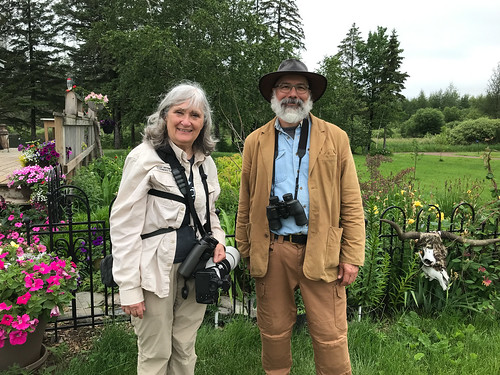 |
| Russell Stewart, the founder of the feast |
As far as I know, Wednesday was the last time the bird appeared. It’s impossible to know which direction she headed off in. If a female Acorn Woodpecker turns up anywhere else in the Midwest this summer, there’ll be a reasonable chance that it’s this one, but she wasn’t banded, so there is no way we can ever be certain.
It’s always fascinating when a bird turns up so far from its home, and thrilling to be able to see it, especially when we have a reasonable hope that it was healthy and has a good chance of returning to its natural range. It’s hard to know what sent this bird our way. Was it one of the fires that are destroying so many California trees in recent years? The horrible drought in the Southwest? That’s another thing we’ll never know—she wasn't talking.
But we do know for certain that one female Acorn Woodpecker turned up for four wonderful days at Russell Stewart’s house in Carlton County, and thanks to his generosity and hospitality, after figuring out that birders and the ornithological community at large would want to know about such a rarity and sharing it on eBird, a host of birders, including me, got to enjoy this extraordinary bird, too.

